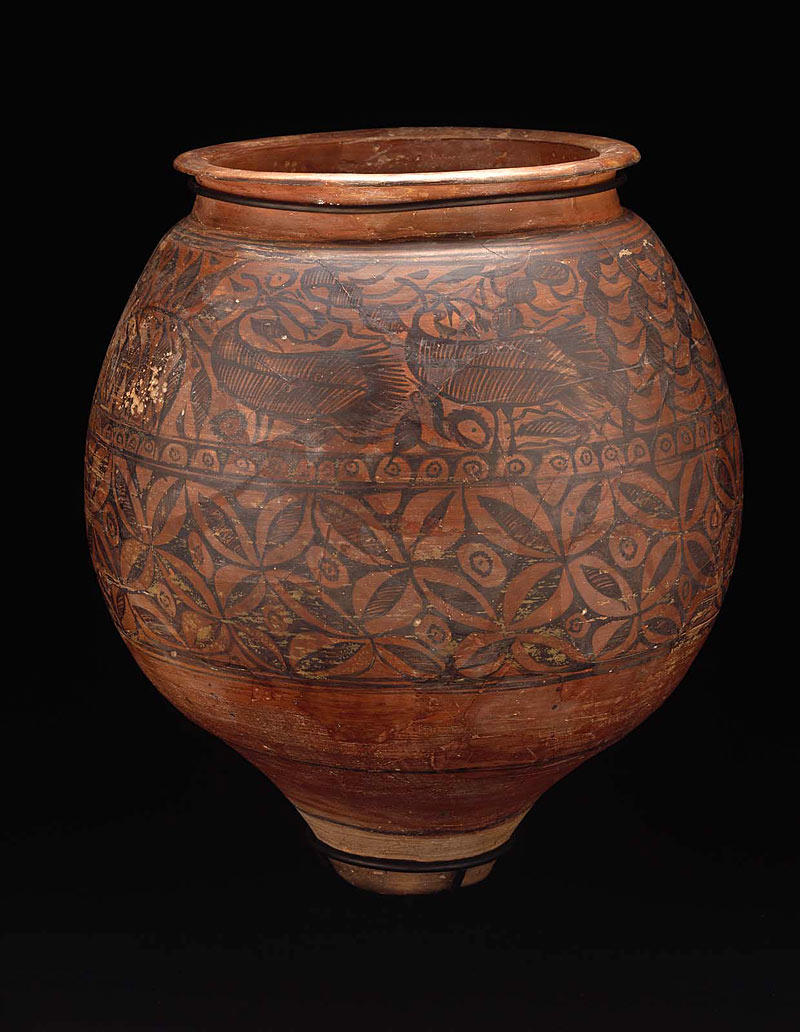
Sold Price Indus Valley Harappan Civilization Pottery Invalid date PDT
ARTS OF THE INDUS VALLEY THE arts of the Indus Valley Civilisation emerged during the second half of the third millennium BCE. The forms of art found from various sites of the civilisation include sculptures, seals, pottery, jewellery, terracotta figures, etc. The artists of that time surely had fine artistic sensibilities and a vivid imagination.

Indus Valley Pottery Bowl w/ Bulls TL Tested Dec 05, 2017 Artemis Gallery in CO Artemis
Harappa ( Punjabi pronunciation: [ɦəɽəppaː]) is an archaeological site in Punjab, Pakistan, about 24 km (15 mi) west of Sahiwal .The Bronze Age Harappan civilisation, now more often called the Indus Valley Civilisation, is named after the site, which takes its name from a modern village near the former course of the Ravi River, which now runs 8.

Painted pottery urns from Harappa (Cemetery H period) Indus valley civilization, Civilization
Harappan civilization: Pottery traditions that existed during this time include- Polished Ware Pottery with rough surface, Burial Pottery of Harappa, Ochre colored pottery (OCP), Black-grey burnished ware, Black-on-red ware, Grey-ware and Painted grey-ware Vedic age:

Harappan Pottery_2, C 2700 2000 BC Ancient pottery, Harappan, Ancient egyptian art
Harappan pottery was made of good quality clay, which was baked in controlled heat in various shapes like bowls, vases, pots (Handi), feeder, dish, storage jar, offering stand, dish-on-stand jars, drinking vessels, cup and cup on a stand, basin, casket and so on.

Harappan Pottery_3, C 2700 2000 BC by Mukul Banerjee Ceramic Clay
The Indus Valley civilization (also called the Harappan era) was one of the earliest known cultures of the Old World, dating from approximately 3,300 to 1,900 BCE,. In Britain there has been a discovery of a piece of pottery from one of the most important civilizations in the ancient world - and it has been serving as a toothbrush holder.

Indus Valley Harappan Civilisation Pottery JarC. 1900 BC.A well painted bubous shaped pottery jar
Some early Kalibangan pottery has a close resemblance to the pottery of the Hakra ware in Cholistan, to other Early Harappan pottery from the Indus Valley Civilization and the pottery of the Integration Era. Functionally, pottery can be classified into household pots, religious and burial purposes. Structurally, we have classes like plain and.

Harappan Civilization Art and Architecture Notes for UPSC
2751 "The pottery found at Harappa is of the light red or brown colour, excepting some specimens which are black. The latter colour is produced by the application of a variety of earth after it has been fired once." Read more An Earthenware Martban and Two Lotas 2750

Indus Valley Geometric Pottery Bowl Harappan
Terracotta figure, Harappa (Pakistan), Indus Valley Civilization (National Museum, New Delhi; photo: Gary Todd) The less numerous male figurines, mostly from the Mature Harappan Phase, are distinguished by their slender form, exaggerated disk-like nipples, headdress and, occasionally, a beard. Exposed genitalia are more common among the earlier.

What Makes a Pot Harappan? Harappa
The forms of art found from various sites of civilisation include sculptures, seals, pottery, gold ornaments, terracotta figures, etc. Their delineation of human and animal figures was highly realistic in nature. Modelling of figures was done in an extremely careful manner. Two major sites of Indus Valley civilization, along the river Indus are.

Harappan Jar Indus Valley, ca. 2500 1800 BC Jul 28, 2019 Helmuth Stone Gallery in FL
The Indus Valley Civilization or Harappan Civilisation (part of Proto-history) was the first urban civilization in South Asia. IVC, Mesopotamian (also called Sumerian (4500-1900 BCE)), and Egyptian (3200-1000 BCE) along with Chinese civilization were the earliest of settlement showing complex societal life.. (Harappa), incised pottery.

Indus Valley Pottery Jar Antelope & Fish Indus Valley Civilization (Harappan Civilization
Pottery in the Indian subcontinent has an ancient history and is one of the most tangible and iconic elements of Indian art. Evidence of pottery has been found in the early settlements of Lahuradewa and later the Indus Valley Civilisation. Today, it is a cultural art that is still practiced extensively in the subcontinent.

Indus Valley Civilization Page 2 The Artistic Adventure of Mankind
The team discovered the oldest pottery from the civilization, which was made during the period called Early Mature Harappan (c. 6,000 years ago) and the pre-Harappan Hakra phase - as far back as 8,000 years. The researchers set out to explore Lothal, Dholavira, and Kalibangan in India. They also dug in a mostly unexplored site, Bhirrana.

Harappan Ceremonial Vessel (Illustration) World History Encyclopedia
Pottery is one of the prominent forms of craft work of the Harappan civilisation. Pottery of the Harappan civilization is of a unique kind. The most striking ceramic ware is a heavy sturdy ware of superior fabric, pink or red in colour in the section and on surface.

Indus Valley, Late Harappan Pottery Vessel with decoration Catawiki
The Indus River Valley Civilization, also known as Harappan civilization, developed the first accurate system of standardized weights and measures, some as accurate as to 1.6 mm. Harappans created sculpture, seals, pottery, and jewelry from materials, such as terracotta, metal, and stone. Evidence shows Harappans participated in a vast maritime.

Harappan Pottery, C 2700 2000 BC Harappan, Pottery, Mohenjo daro
Alexander Cunningham made a few small excavations at the site and reported some discoveries of ancient pottery, some stone tools, and a stone seal. Cunningham published his finds and it generated some increased interest by scholars. It wasn't till 1920 that excavations began in earnest at Harappa.

Bowl with painted decoration Indus Early Harappan The Metropolitan Museum of Art
The Indus River Valley Civilization, 3300-1300 BCE, also known as the Harappan Civilization, extended from modern-day northeast Afghanistan to Pakistan and northwest India. Important innovations of this civilization include standardized weights and measures, seal carving, and metallurgy with copper, bronze, lead, and tin.